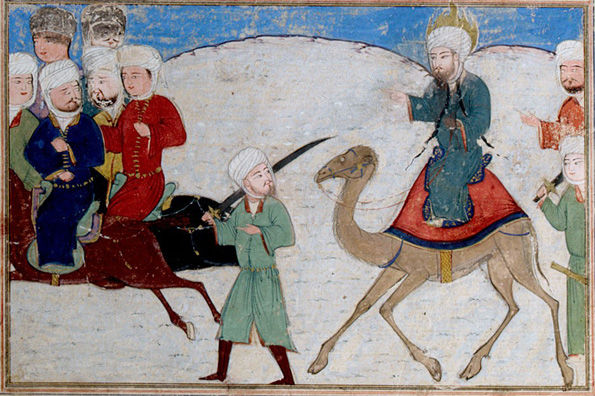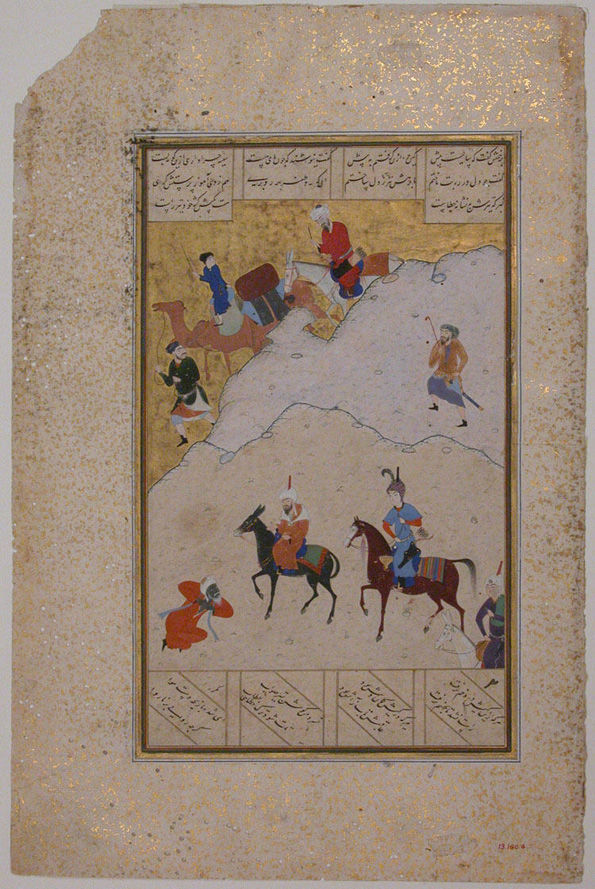Hafiz-i Abru (d. 1430). Detail from "Journey of the Prophet Muhammad," Folio from the Majma al-Tavarikh (Compendium of Histories), ca. 1425. Present-day Afghanistan, Herat. Ink, opaque watercolor, and gold on paper. The Metropolitan Museum of Art, New York, Cora Timken Burnett Collection of Persian Miniatures and Other Persian Art Objects, Bequest of Cora Timken Burnett, 1956 (57.51.9)
The words "pilgrimage" and "sacred space," one evoking human movement and the other performative space, are inseparable from one another. Through pilgrimage, the pilgrim embarks on a spiritual path toward the full submission to God in an often-distant sacred space. For Muslims, pilgrimage, or hajj, is the most sacred ritual performance through which pilgrims, al-hajij, annually unveil their sins to God for purification. The core of the ritual takes place in the holiest cities of the Arabian peninsula (al-jazeera al-‘arabiyya), Mecca and Medina (madinat al-munawarrah, or "Medina the Radiant"), during the first ten days of the month Dhu al-Hijjah in the lunar hijri calendar of Islam.
Nestled among the mountain passes of central western Arabia fifty miles inland from the Red Sea is the city of Mecca, or makkat al mukarrama (the honored Mecca). Imbued with holiness well prior to the rise of Islam, al-haram al makki (The Holy Site of Mecca) served as the most sacred congregational place for tribes of the Arabian peninsula since the erection of the Ka’ba. According to Islamic tradition, God commissioned Ibrahim (Abraham) with the help of his son Isma’il (Ishmael) to go and build an edifice, the Ka’ba, where people would gather and worship only Him.
Amir Khusrau of Delhi. "Muslim Pilgrim to Mecca Meets a Brahman on the Road," Folio from a Khamsa (Quintet) of Amir Khusrau Dihlavi, 1520–25. Iran. Ink, opaque watercolor, and gold on paper. The Metropolitan Museum of Art, New York, Rogers Fund, 1913 (13.160.4)
Tribes came from all directions to visit the Ka’ba, bait Allah al-haram (The Holy House of God) for pilgrimage and in order to commemorate the God of Ibrahim. Over time, idolatry (Wathaniyya) became widespread among the inhabitants of the Arabian Peninsula. Quraysh, the leading tribe of Mecca and its vicinities—amongst whom later emerged the Prophet Muhammad—set idols around the Ka’ba, the most important of which were Hubbal, Ilaat, and Na’ila.
Local, regional, and trans-regional tribes traveled to Mecca not only for its religious significance, but also for its role as a commercial center. The city's strategic location along the old caravan trade route connecting South Arabia, East Africa, and South Asia with the Mediterranean world attracted Arabs as well as non-Arabs. Both the Romans and Byzantines, for example, long maintained commercial relations with the people of Mecca, considering the city an essential nodal point in trade circulation of the Red Sea.
After a long struggle between the Prophet Muhammad and the people of Quraysh, which initially led to his emigration, or Hijra, from Mecca to Medina in 622, the monotheism of Ibrahim returned to Mecca. In the tenth year of his emigration, the Prophet Muhummad returned to Mecca along with almost ten thousand Muslims. This was also the year in which Muslims revived hajj as an Islamic ritual that was obligatory for every male and female Muslim physically and economically able to make the journey.
Through the centuries and until today, hajj, the fifth pillar of Islam, has served to gather millions of Muslims annually from around the world in unity. Along with its religious significance, it has played important social, intellectual, and economic roles by stimulating the meeting of people from disparate locales, the exchange of ideas, and widespread commercial exchange.

